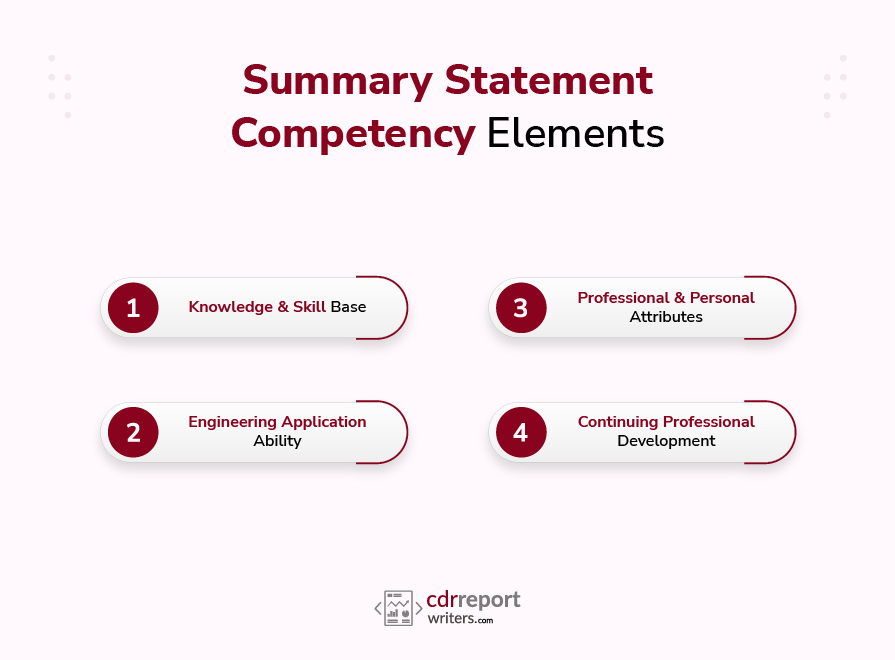How to write an effective Summary Statement for your CDR Report?

How to write an effective Summary Statement for your CDR Report?
The Summary Statement is an essential component of the Competency Demonstration Report (CDR) required by Engineers Australia (EA) for skilled migration applications. It is a crucial document that showcases an engineer’s qualifications and experience to assess their suitability for skilled migration to Australia.
A well-crafted Summary Statement is essential to present your engineering skills and achievements concisely and compellingly, ensuring that your CDR stands out among other applicants. This comprehensive blog will delve into the essential elements of writing an effective Summary Statement that maximizes your chances of success with EA.
Purpose of the Summary Statement
The Summary Statement is a cross-referencing document that links specific competency elements claimed in your Career Episodes to the relevant sections of the Migration Skills Assessment Booklet. It is a vital part of the CDR as it allows the assessors to quickly gauge your proficiency in engineering skills and understand how you have applied them in your professional career.
Summary Statement Competency Elements
The Engineers Australia competency elements are fundamental pillars that form the basis of the Competency Demonstration Report (CDR) assessment process. To ensure a successful CDR submission, it is crucial to deeply understand each competency element and how they relate to your engineering experience.
Let’s delve into each category to comprehend its significance and the key aspects to consider when addressing them in your Summary Statement.

1. Knowledge and Skill Base
The Knowledge and Skill Base elements focus on demonstrating an engineer’s theoretical knowledge and technical expertise in specific engineering disciplines. These elements highlight the academic foundation and understanding of engineering principles essential for practicing engineers.
Engineers must demonstrate proficiency in fundamental subjects such as mathematics, physics, chemistry, and engineering design. When addressing KS elements in your Summary Statement, emphasize how your academic background and technical training have equipped you with the necessary knowledge to excel in your engineering field.
Mention any specialized courses, certifications, or additional training you have undertaken to enhance your technical capabilities. Moreover, link these competencies to specific indicators in the EA Handbook to provide concrete evidence of your proficiency.
Read More: Skillselect Visa Categories: Which visa pathway is Right for You? ✈️✈️
2. Engineering Application Ability
The Engineering Application Ability elements focus on applying engineering knowledge and skills in real-world scenarios. These elements assess an engineer’s problem-solving capabilities, design expertise, project management skills, and ability to adapt theoretical knowledge to address complex engineering challenges effectively.
When addressing EA elements in your Summary Statement, provide specific examples from your Career Episodes that showcase how you applied engineering principles to solve problems, design innovative solutions, and manage engineering projects.
Demonstrate your hands-on experience and highlight the outcomes achieved through your engineering endeavors. Align your achievements with the relevant indicators in the EA Handbook to substantiate your claims.
3. Professional and Personal Attributes
The Professional and Personal Attributes elements assess an engineer’s soft skills, ethical behavior, communication abilities, teamwork, and leadership qualities. These elements demonstrate an engineer’s commitment to professional conduct, teamwork, and ethical practices, which are essential for successful engineering practice.
When addressing PP elements in your Summary Statement, focus on showcasing instances from your Career Episodes that highlight your effective communication, ethical decision-making, teamwork, and leadership experiences.
Provide examples of how you resolved conflicts, demonstrated leadership, and collaborated with diverse teams to achieve project objectives. Relate these instances to the specific indicators in the EA Handbook to convincingly illustrate your professional and personal attributes.
4. Continuing Professional Development
The Continuing Professional Development elements focus on an engineer’s commitment to lifelong learning and staying updated with advancements in their engineering discipline. Engineers are encouraged to engage in various CPD activities, such as workshops, seminars, conferences, and further education, to enhance their professional skills continually.
When addressing CPD elements in your Summary Statement, highlight your dedication to continuous learning and professional growth. To stay updated on the latest trends and developments in your engineering field, provide a comprehensive overview of your CPD activities, such as workshops, certifications, technical courses, and conferences.
Connect these activities to the specific indicators in the EA Handbook to demonstrate your proactive approach to professional development.
Visit: How to make an ideal CV for a skills assessment? 📑📑
Structuring the Summary Statement
The Summary Statement should follow a well-organized structure facilitating easy cross-referencing with the Career Episodes. Each competency element should be addressed with a unique paragraph and identified with a unique code for reference. The format is as follows:
Paragraph 1: Introduction and EA element code
Paragraph 2: Description of the engineering activity
Paragraph 3: Personal Engineering Activity
Paragraph 4: Summary of the competency element’s demonstration
Below is the structure that you can follow while preparing the summary statement:
1. Showcasing Your Engineering Activities
In Paragraph 2 of the Summary Statement, briefly describe the engineering activity from the corresponding Career Episode. Use action-oriented language and highlight your responsibilities, challenges faced, and outcomes achieved. It should be clear, concise, and directly linked to the competency element under consideration.
To effectively showcase your engineering activities:
a. Be Specific: Provide specific details about the project or task you were involved in, including the type of project, its scope, and your role in the team.
b. Highlight Achievements: Emphasize the positive outcomes of your engineering work, such as cost savings, efficiency improvements, or successful project completion.
c. Mention Challenges: Address any significant challenges you encountered during your project and how you overcame them.
d. Use Metrics: Whenever possible, quantify your achievements using measurable metrics or data to add credibility to your claims.
e. Stay Focused: Stick to the relevant engineering details and avoid unnecessary information that may divert the assessor’s attention.
Read more: Engineering Jobs in Australia: A comprehensive list for Skills Assessment 📑📑
2. Focusing on Personal Engineering Activity
Paragraph 3 of the Summary Statement requires you to elaborate on your Personal Engineering Activity (PEA). This activity is crucial as it showcases how you have personally contributed to the engineering activity mentioned in Paragraph 2.
Be specific about your role, actions, and decision-making abilities. Highlight how you applied your engineering knowledge and skills to accomplish the task. To effectively present your Engineering Activity:
a. Emphasize Your Role: Explain your role in the engineering activity and how you contributed to its success.
b. Demonstrate Technical Competence: Discuss the engineering principles, theories, and best practices you applied to achieve your objectives.
c. Describe Problem-Solving: Explain any challenges or obstacles you encountered and how you approached problem-solving.
d. Showcase Leadership Skills: If applicable, highlight your leadership abilities and how you motivated and guided your team.
e. Highlight Innovations: Mention any innovative approaches or ideas you introduced to enhance the project’s outcome.
3. Summarizing the Competency Element’s Demonstration
In Paragraph 4, provide a concise summary addressing the competency element. Here you can link your engineering activity with the specific element and demonstrate how you have met the required standards. Use the EA Handbook as a reference and focus on the specific indicators to make a strong case for your competencies.
To effectively summarize the competency element’s demonstration:
a. Use EA Indicator Codes: Include the relevant EA indicator codes to reference the addressed elements.
b. Align with Indicators: Explain how your engineering activity aligns with each competency indicator and how you have met or exceeded the required criteria.
c. Showcase Multiple Elements: If a single engineering activity addresses multiple competency elements, link each separately with its respective indicators.
d. Provide Evidence: Support your claims with evidence from your Career Episodes, such as project reports, drawings, calculations, or testimonials.
e. Quantify Achievements: Quantify your achievements to provide tangible evidence of your engineering capabilities.
Read more: Perfect CDR for an Agricultural Engineer 📑📑
4. Utilizing the STAR Method
To enhance the effectiveness of your Summary Statement, consider using the STAR (Situation, Task, Action, Result) method for describing your engineering activities. This method helps structure your responses and provides a clear understanding of your accomplishments to the assessors.
a. Situation
Describe the context and background of the engineering activity.
b. Task
Explain the specific task or challenge you were assigned.
c. Action
Detail your actions and the methodologies you employed to address the task.
d. Result
Highlight the positive outcomes and the impact of your actions on the project or organization.
By utilizing the STAR method, you provide a well-structured and comprehensive overview of your engineering experiences, making it easier for assessors to evaluate your competency.
5. Incorporating Technical Keywords and Phrases
Engineers Australia uses specific technical keywords and phrases in their competency indicators. Ensure that you include these relevant technical terms throughout your Summary Statement. This term demonstrates your understanding of the engineering concepts and aligns your experience with EA’s requirements.
To effectively incorporate technical keywords:
a. Review the EA Handbook: Carefully review the EA Handbook and note the technical terms and phrases used in each competency element.
b. Integrate Naturally: Integrate technical keywords naturally into your writing, ensuring they fit contextually and enhance the clarity of your statements.
c. Avoid Overuse: While it is essential to include relevant technical terms, avoid overusing them to the point where they detract from the readability of your Summary Statement.
d. Demonstrate Understanding: Use technical keywords in contexts that demonstrate your understanding and application of the associated engineering concepts.
6. Presenting Clear and Concise Information
The Summary Statement should be written concisely and grammatically correctly. Avoid unnecessary jargon and focus on demonstrating your engineering abilities effectively. You can use bullet points or numbered lists to make the document more reader-friendly.
To present clear and concise information:
a. Use Clear language: Express your engineering experiences in straightforward language to ensure clarity and ease of understanding.
b. Remove Redundancies: Avoid repeating information already mentioned in the Career Episodes. Focus on providing additional context in the Summary Statement.
c. Prioritize Key Points: Highlight the most significant achievements and experiences that align with the competency elements.
d. Avoid Repetition: Each competency element should have unique information, so avoid duplicating content across different paragraphs.
e. Check Grammar and Spelling: Proofread your Summary Statement to eliminate grammatical or spelling errors.
Read more: How to become a licensed professional engineer in Australia? 📑📑
7. Seeking Peer Review
After completing your Summary Statement, seek feedback from peers or mentors with experience in the CDR application process. Their valuable input can help you refine your Summary Statement, ensuring you have covered all the necessary competency elements and presented them convincingly.
To make the most of peer review:
a. Choose Trusted Reviewers: Select individuals with a good understanding of the CDR requirements and those who can provide constructive feedback.
b. Consider Multiple Reviews: Seek feedback from multiple sources to gain various perspectives and identify improvement areas.
c. Be Open to Critique: Embrace feedback with an open mind and be willing to make necessary revisions to enhance the quality of your Summary Statement.
d. Verify Clarity and Coherence: Ensure that your Summary Statement is clear, coherent, and effectively demonstrates your engineering competencies.
Conclusion
Writing an effective Summary Statement for your CDR is crucial to demonstrate your engineering capabilities and securing a positive assessment from the Department of Home Affairs and Engineers Australia. By understanding this guide’s purpose, structure, and essential tips, you can prepare a compelling Summary Statement that reflects your achievements and aligns with EA’s competency requirements.
Remember to emphasize showcasing your engineering activities, incorporating technical keywords, and providing clear, concise, and well-organized information. With meticulous preparation and attention to detail, you can increase your chances of a successful CDR assessment and realize your dream of skilled migration to Australia.

 WhatsApp Quick Contact
WhatsApp Quick Contact

 WhatsApp Quick Contact
WhatsApp Quick Contact
